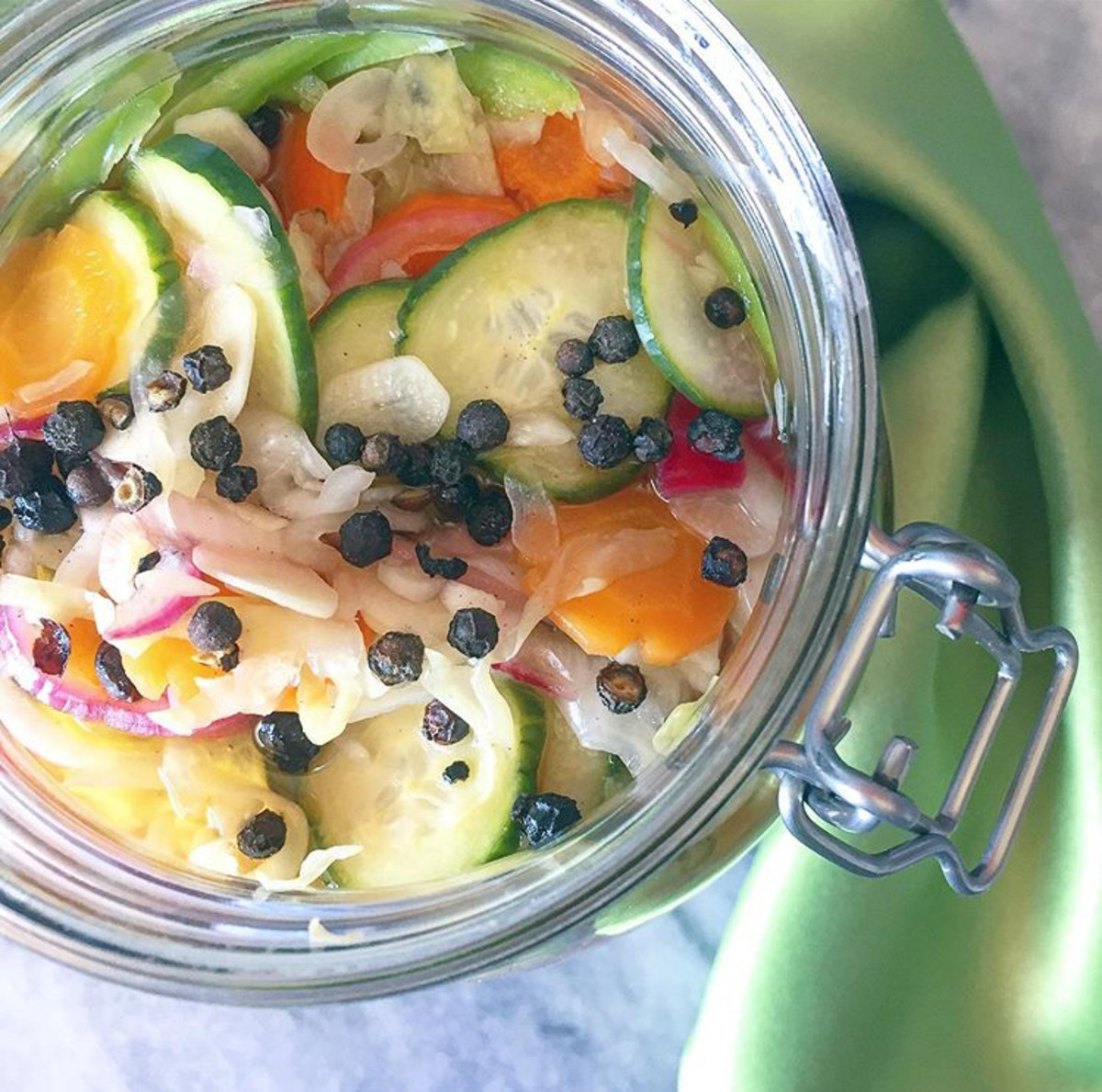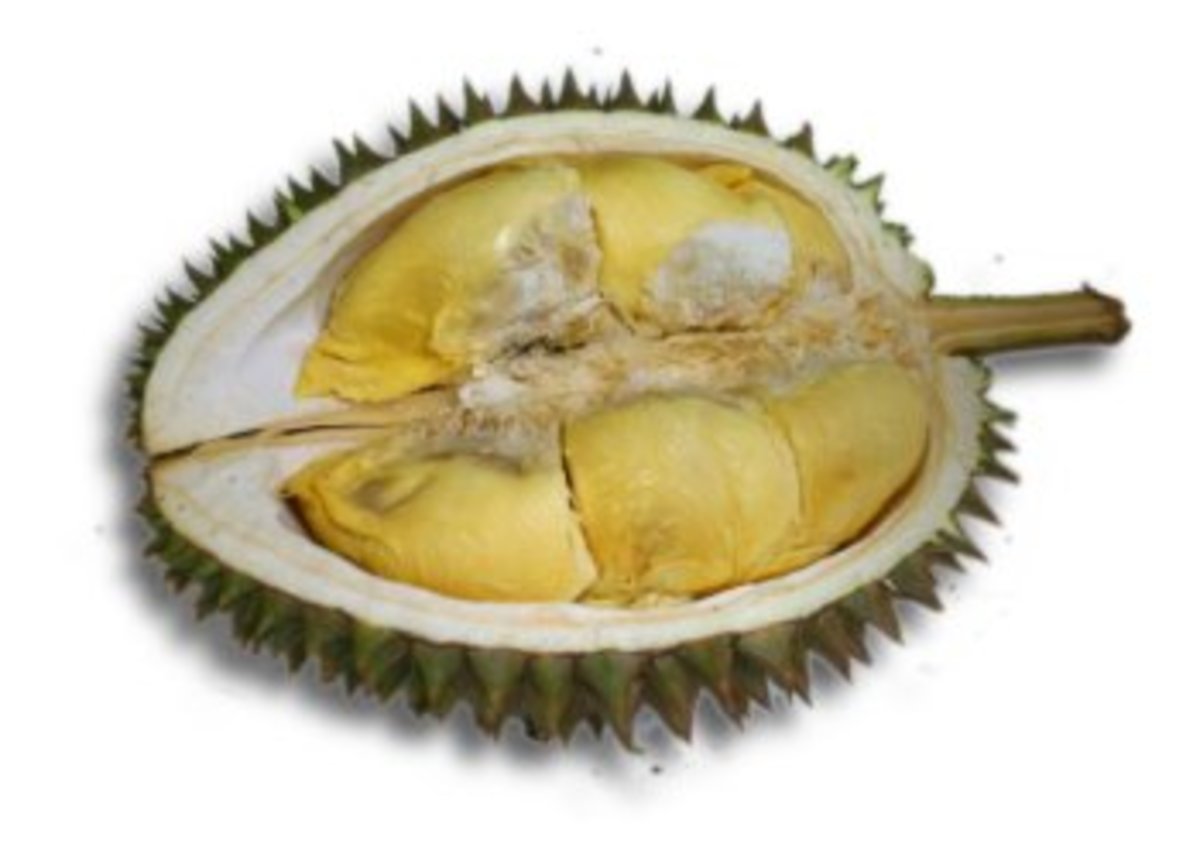How to Make Homemade Sauerkraut
Raised by my grandparents, I grew up in a German home. My grandparents even spoke German when they wanted to talk to each other and did not want us to know what they said. Often times, I believe they were using words that they would not have permitted us to use ... but I digress. We consumed many traditional German dishes including sauerkraut.
Every year my grandmother raised a long row of cabbage in the garden so that we would be able to produce enough kraut to last the whole next year. When the cabbage was harvested, we spent hours cutting the heads into slivers of cabbage to create some of the best sauerkraut I have ever tasted.
If you've never made sauerkraut, I urge you to give it a try. You will be amazed at how easy it really is. And the health benefits are out of this world.
If you have never enjoyed the highly processed sauerkraut that can be found on the grocery store shelves because you found the taste to be too intense, I encourage you to make some for yourself. Eating it after just 2 weeks of lacto-fermentation will provide you with a kraut that is extremely mild. The longer it ferments, the more intense the "sour" flavor becomes.

Sauerkraut is a Natural Source of Probiotics
Sauerkraut, which is easy to make and a tasty addition to any diet, is also an excellent source of natural probiotics - the very same probiotics that are found in yogurt. Lactobacillus is a by-product of the fermentation process that cabbage undergoes on its way to becoming what we know as sauerkraut. To learn more about the health benefits of sauerkraut and other lacto-fermented foods, check out, Lacto-Fermentation and Food.
Sauerkraut Can Be Served a Variety of Ways
Sauerkraut can be served:
- Naturally – raw, served straight from the fermenting crock or jar
- Chilled as a salad. Sprinkle with a dash of celery or caraway seeds for a change of pace.
- Served as an appetizer. Can be served with a few chunks of chilled, drained canned pineapple or a little pineapple juice.
- Heated for a few minutes; serve with sausage or frankfurters. To maintain the most tang and the greatest crispness, just barely heat it through. If milder flavor is desired, cook a little longer. Remember that cooking will kill many of the beneficial bacteria that are cultured during the fermentation process.

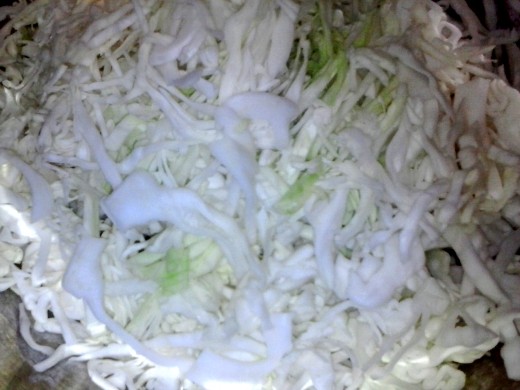
How to Make Sauerkraut in Pint or Quart Jars
Making sauerkraut is easy.
Just follow these simple directions and you could be eating your own finely crafted sauerkraut in 2 weeks time.
3 Basic Ingredients Are Needed to Make Sauerkraut
- 1 average head of cabbage
- salt
- water
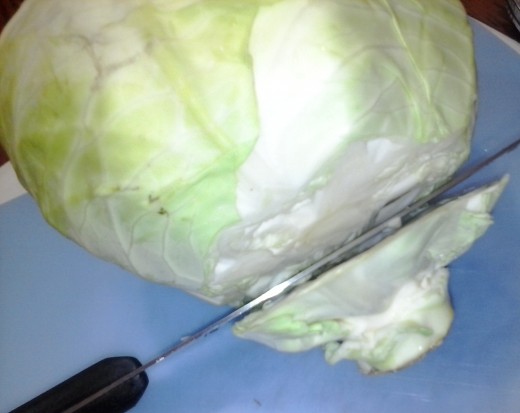
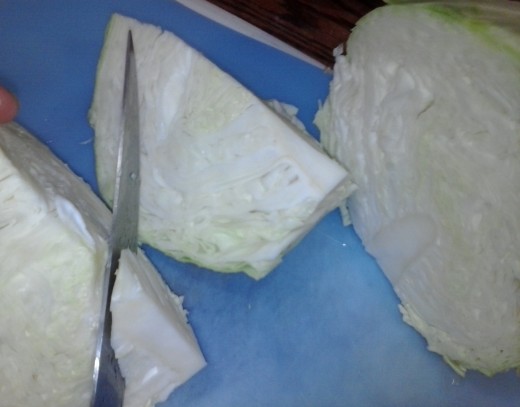
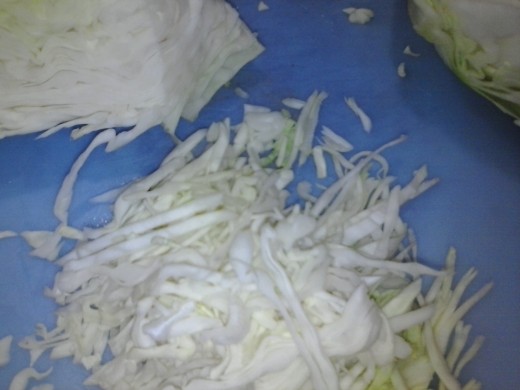
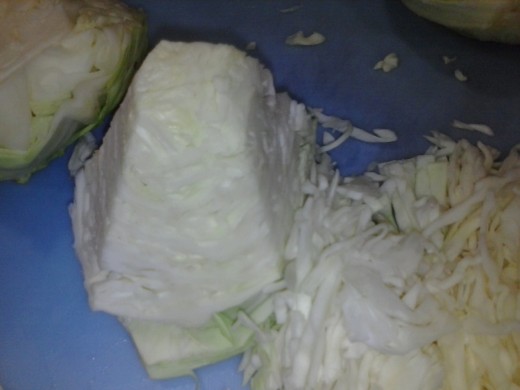
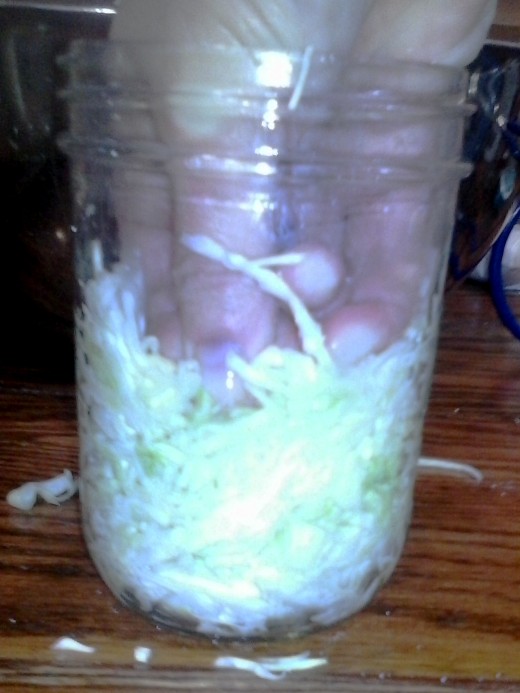
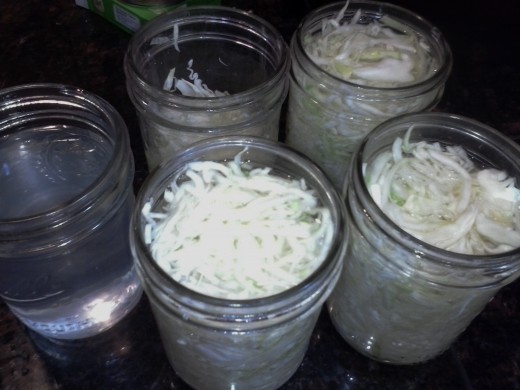
You will need a kitchen scale to accurately measure the cabbage so you know how much salt to add to your mixture. The one shown below should work very well for you. Remember to weigh the bowl before beginning and add that weight to your cut cabbage.
- Remove and discard the outer leaves from heads of cabbage that are firm and mature. Wash well, drain. Remove the base of the head. (Figure 1-1) Quarter the heads. Remove and discard the cores. (Figure 1-2)
- Shred 2-1/2 pounds of cabbage at a time (approximately 1 head) with a sharp knife. The slices should be no thicker than a dime. (Figure 1-3) Turning the cabbage quarters as you cut (Figure 1-4) makes the job easier. It also makes the sauerkraut easier to eat.
- Sprinkle with 1-3/4 tablespoon of salt. Mix thoroughly by hand.
- Pack into clean glass jars. I like to use wide-mouth canning jars because I can compress the cabbage into the jars with my fist. (Figure 1-5) Otherwise, press cabbage down firmly with a plastic or wooden spoon. One head of cabbage can usually be pressed into 2 quart jars. Any excess can be placed in a third jar. If using pint jars (my favorite for 2 people), 5-6 pints usually work well.
- Wipe off the top edges of the jars. As shown in Figure 1-6, the jars have cabbage and salt that will need to be removed from the rims. Cover the cabbage with folded cheesecloth pads, tucking the edges down against the inside of the jar. Hold down the cabbage by crisscrossing two dry wood strips, or wood strips coated with melted paraffin.
- Make a brine mixing 1-1/2 tablespoons salt in 1 quart lukewarm water. Pour brine over the cabbage in the jars, completely covering the cabbage. Extra brine can be mixed and stored in an additional jar to make topping off the jars easy. (Figure 1-6)
- Wipe off the outside of the jars. Put on lids but do not seal tightly. Movement should be allowed because during the fermentation process, air and liquid will need to escape.
- Because the brine may overflow during the fermentation process, place the filled jars in shallow pans or on folded newspapers. Store jars at room temperature. 70 degrees is the ideal temperature for quality sauerkraut. (I have found that a spare bathroom with the door closed maintains this ideal temperature.)
- If a film forms on top of the liquid, skin every few days. If these directions have been followed and the jars have been stored at the appropriate temperature, little or no film should form.
- IT IS VERY IMPORTANT to keep the cabbage covered with brine. If necessary, add more brine to the jars. Additional brine can be made by dissolving 1-1/2 tablespoons of salt into 1 quart of lukewarm water. Remove the cheesecloth and the wood strips to add brine if needed.
- Let the cabbage ferment 10-14 days, or until the liquid settles and bubbles are no longer rising to the surface. Sauerkraut can be fermented longer if a sharper flavor is desired.
- If sauerkraut is to be used within a few weeks, wipe the mouths of the jars and seal tightly. Store the jars in a cool place. If longer storage is to be used, remove the lids and place the jars in a pan of cold water. Water should extend up to the shoulders of the jars. Slowly bring the water to a boil. Remove a jar, add boiling brine (brine mix: 1-1/2 tablespoons salt to 1 quart of water) to the jar, covering the sauerkraut, and to within 1/2 inch from the top. Wipe off the jar rims. Firmly screw down lids. Process in boiling water bath (212 degrees) Pint jars: processed 20 minutes Quart jars: processed 20 minutes.
- Remove jars from the water bath; place on a heat safe surface (I use a folded towel on my granite counter or my wooden island top) with several inches of spacing between the jars. Allow to cool completely.
Don't Make "Railroad Tracks"
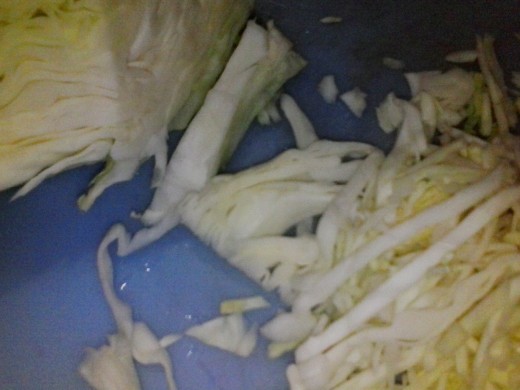
How to Make Sauerkraut in a Stone Crock
My grandmother always made her sauerkraut in a large stone crock. She placed a plate just smaller than the diameter of the crock over the cut cabbage and held it down with a large nonporous rock. The plate and rock worked well to hold the cabbage down making sure that it was always submerged in the brine.
This method of making sauerkraut works well when larger batches of sauerkraut are being made.
- Prepare cabbage as directed for pint and quart jar recipe above, shredding and salting no more than 5 pounds of cabbage at a time. To each 5 pounds of cabbage, add 3-12 tablespoons of salt. Mix thoroughly by hand.
- Wash stone crock in warm soapy water, rinse well and scald. Washing beforehand in the dishwasher works very well.
- Pack the shredded and salted cabbage firmly using a potato masher into the stone crock. Repeat this process until crock is filled to within 5" of the top. Using the potato masher, press cabbage firmly trying to extract enough juice from cabbage to cover the mixture. A weak brine may be mixed dissolving 1-1/2 tablespoon of salt in 1 quart of water. The cabbage needs to be covered with liquid at all times.
- Cover the cabbage with two or more layers of clean cheesecloth, tucking the edges in against the inside of the jar.
- Place a scalded, heavy plate that just fits inside the crock over the cheesecloth. A paraffined board can be used as well. Weight the plate or board down with a jar filled with water or a nonporous stone (do not use limestone), until the juice/brine is forced over the plate.
- Fermentation will begin the next day. Higher temperatures can cause the sauerkraut to spoil. 70 degrees F is the ideal temperature.
- Daily care is needed. Remove any film that forms on the surface of the liquid. Wash and scald the cover cloth and plate as often as needed to remove mold and film.
- When bubbling stops, usually within 2-3 weeks (longer in colder weather), tap the crock gently. If no bubbles rise to the surface, the lacto-fermentation process has ended.
- For long-term storage, canning may be necessary. The sauerkraut will hold in the stone crock as long as a cold temperature of 55 degrees F or less is maintained. If canning is to be done, pack the fermented sauerkraut into pint or quart jars within 1" from the top. Cover the sauerkraut with juice from crock. If more juice is needed, mix a weak brine using 1-1/2 tablespoon of salt to one quart of water.
- Set packed jars in a pan of cold water. Water should come up to the shoulder of the jars. Bring water slowly to a boil. Remove the jars. Wipe off the rims of the jars. Adjust the lids. Process in a boiling water bath completely submerging the jars. Process pint jars for 20 minutes, quart jars for 30 minutes.
Whichever method you choose, always use pure granulated salt to make the sauerkraut. Measure it accurately as it will not ferment properly if too much salt is added.
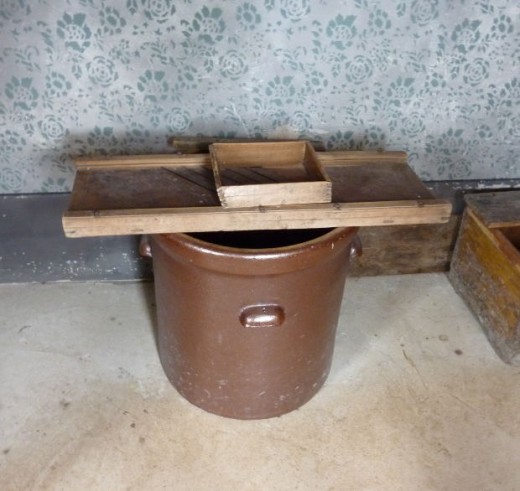
The longer sauerkraut ferments, the better the flavor becomes. Some people even say that the best flavor is obtained after about 6 months of proper storage.
When you open a jar of sauerkraut, always be sure to use a clean utensil so as not to introduce new bacteria into the jar. The sauerkraut should be crisp and feel clean – never slimy or rotten smelling. Living raw sauerkraut has a distinct smell which should remain the same all the way down to the bottom of the jar.
| Nutrition Facts | |
|---|---|
| Serving size: 1 cup (142 g) | |
| Calories | 27 |
| Calories from Fat | 0 |
| % Daily Value * | |
| Carbohydrates 6 g | 2% |
| Sugar 2 g | |
| Fiber 4 g | 16% |
| Protein 1 g | 2% |
| Cholesterol 0 mg | |
| Sodium 939 mg | 39% |
| * The Percent Daily Values are based on a 2,000 calorie diet, so your values may change depending on your calorie needs. The values here may not be 100% accurate because the recipes have not been professionally evaluated nor have they been evaluated by the U.S. FDA. | |
Sauerkraut Q & A
When making sauerkraut, especially the first few times, you may find yourself faced with a few questions. If your sauerkraut doesn't turn out exactly as your thought it should, you may ask yourself if if is safe to eat. Hopefully this section will answer many of those questions.
First of all, if your sauerkraut smells good (if you like the smell of sauerkraut) and it is nice and crisp, then it hasn't spoiled. Homemade raw and unprocessed sauerkraut is crunchy and tastes great, and spoilage of sauerkraut is an uncommon occurrence.
Scraping slimy kraut or mold from the top of the sauerkraut will not make the sauerkraut safe to eat. Although not visible, the bacteria and yeast that cause these issues have roots that extend into the body of the sauerkraut.
What causes slimy sauerkraut?
Certain bacteria cause sauerkraut to be slimy.These bacteria flourish when the temperatures are too high or when not enough salt has been used.
Slimy sauerkraut should not be consumed.
What causes sauerkraut to turn pink?
Certain kinds of yeast will cause the sauerkraut to develop a pink color. These yeasts can form in the sauerkraut when the salt has not been evenly distributed, when too much salt has been used, or if the cabbage has been packed too loosely.
If the sauerkraut is pink colored or slimy, it has spoiled. It should not be eaten.
What causes sauerkraut to be soft?
Several things can result in "soft" sauerkraut:
- Not enough salt
- High temperatures during fermentation
- Jars or crock that has not been cleaned properly
- Air pockets inside the packed sauerkraut
Is the use of too much salt a bad thing?
yes, too much salt can prevent fermentation.
How can you prevent the formation of a white film?
In order to prevent the formation of a white film, the sauerkraut must be covered completely. The sauerkraut, as well as its juice, should have as little contact with the air as possible. If this becomes a problem for you, using a baggie filled with water to hold down the plate or board will help eliminate this issue.
In closing ...
If you in any way doubt the safety of the sauerkraut you have fermented, it is best to discard it. The cost of a few heads of cabbage and the salt used to process is minimal compared to the illness that could result from consuming the sauerkraut.
© 2015 Cindy Murdoch




